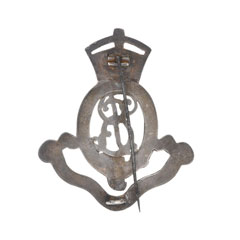
Online Collection
Pugri badge, 33rd Queen's Own Light Cavalry, 1903-1911
Silver badge in the form of the royal cypher, 'ER', within a garter bearing the motto of the Order of the Garter, 'Honi soit qui mal y pense' (Shame on him who thinks evil of it), surmounted by an Imperial Crown, with a scroll below bearing the unit title, '33rd Queen's Own Light Cavalry'.
The pugri or pagri is a form of headdress.
The 33rd Queen's Own Light Cavalry traced its origins to the raising of the 3rd Regiment of Bombay Light Cavalry in 1820. It had briefly been renamed 3rd Regiment of Bombay Silladar Light Cavalry in 1861, only to revert to its original title in the same year. It was renamed 3rd (The Queen's Own) Regiment of Bombay Light Cavalry in honour of Queen Victoria accepting the title of Empress of India, before being renamed 33rd Queen's Own Light Cavalry in 1903 as part of Lord Kitchener's reforms of the Indian Army.
In 1911, on the occasion of the Delhi Durbar to mark King George V becoming Emperor of India, the regiment was retitled as the 33rd Queen Victoria's Own Light Cavalry, to make clear it was named for Victoria who had granted the title 'Queen's Own' rather than Queen Mary.
At the outbreak of World War One in 1914, the regiment consisted of one squadron each of Jats, Sikhs, Kaimkhanis and Musalman Rajputs, and was stationed at Aurangabad, but were dispatched to Mesopotamia in November 1914 as part of the 6th (Poona) Division to secure Anglo-Persian Oil Company interests.
By February 1915 the regiment was part of the 6th Indian Cavalry Brigade, which remained in Mesopotamia for the duration of the war. It saw action at the Battle of Shaiba, the advance on Baghdad and the Battle of Ctesiphon but had left the division before the disastrous Siege of Kut, which ultimately saw the surrender of the 6th (Poona) Division. After landing at Karadu, the 33rd went to Lahore where it remained for the rest of the war. For their role in the Mesopotamia Campaign, the regiment was awarded the battle honours 'Shaiba', 'Ctesiphon', 'Tigris 1916' and 'Mesopotamia 1914-16'.
In 1919 the regiment also participated in the 3rd Afghan War (1919), earning the battle honour 'Afghanistan 1919', and in 1921 it amalgamated with 34th Prince Albert Victor's Own Poona Horse to become 33rd/34th Cavalry but was renamed as the 17th Queen Victoria's Own Poona Horse in 1922.
From the Field Marshal Sir John Chapple Indian Army Collection.
NAM Accession Number
NAM. 2013-10-20-18-10
Copyright/Ownership
National Army Museum Copyright
Location
National Army Museum, Study collection
Object URL
https://collection.nam.ac.uk/detail.php?acc=2013-10-20-18-10


